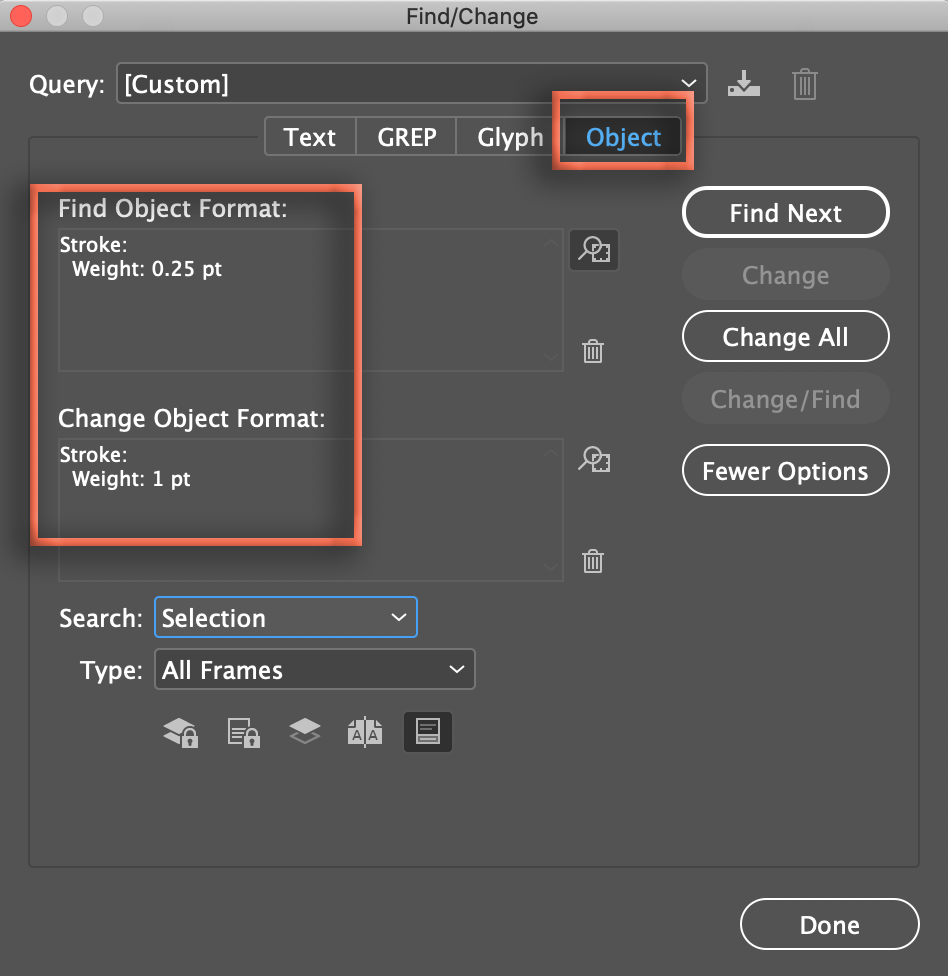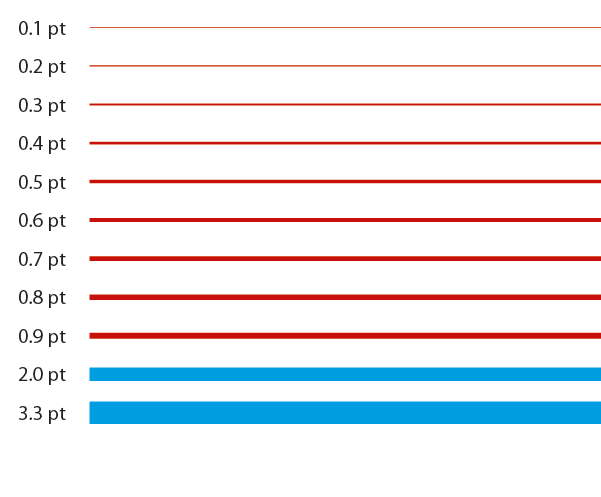- Home
- InDesign
- Discussions
- Re: How find strokes with different thicknesses
- Re: How find strokes with different thicknesses
Copy link to clipboard
Copied
Is there a way to find and replace all the strokes comprised between different thicknesses, for example between 0.01 pt and 0.09 pt with strokes of 0.1 pt thickness?
 1 Correct answer
1 Correct answer
There you go. Save as "fixHairlines.jsx" in your own personal Scripts folder (if this sounds daunting, read https://indesignsecrets.com/how-to-install-a-script-in-indesign-that-you-found-in-a-forum-or-blog-post.php ), double-click to run. It presents a simple dialog in which you can fill in the minimum and maximum weights to change (both inclusive) and the weight to change to.
Did only a very small test but I foresee no problems. InDesign pops up an automatic message if you try to find objects on
...Copy link to clipboard
Copied
Not really; but isn't it easy enough to select all of your objects and then apply your new stroke weight?
Copy link to clipboard
Copied
For others reading this thread who just want to update one variation—and not a range of variations—you can use an Object Find/Change.

~Barb
Copy link to clipboard
Copied
Let me explain better, I have a catalog of 64 pages, some strokes have been scaled in percentage and have a thickness that is 0.08 pt, but this thickness is not real because it is rounded by indesign (the actual measurement would be 0.07953 pt), so if I look for all tracks with a thickness of 0.08 pt I can't find anything.
Copy link to clipboard
Copied
Leave the value blank in Search, and set 0.08 in Replace.
And if you need to change again, you now can Find value 0.08 and change that. But, big But, it will change AL lines to 0.08 when left blank, I don't know if that presents a problem of course f you need other line values NOT to change...
Anyway, a 'find 00.8 or any maller value' (a conditional search) is not possible...
Copy link to clipboard
Copied
Not good because in this way because so all lines become 0.08 pt, while I want for example that those of 0.2 pt are not changed and those of 0.5 pt are not changed, but replace only those included between 0.01 and 0.09 pt with 0.1 pt
Copy link to clipboard
Copied
Hi bebez71:
replace only those included between 0.01 and 0.09 pt
I agree with [Jongware]'s initial assessment. There is no easy way to do this where you are trying to find a range of weights. But on a public forum like this one, someone will search for how to globally find all the lines of a specific weight, and that's why I added to his answer.
~Barb
Copy link to clipboard
Copied
InDesign has a lot of exciting features. Well, not this one. FWIW, Acrobat has something close (Tools > Print Production > Fix Hairlines):

Copy link to clipboard
Copied
bebez71 wrote
.. I have a catalog of 64 pages, some strokes have been scaled in percentage and have a thickness that is 0.08 pt, but this thickness is not real because it is rounded by indesign (the actual measurement would be 0.07953 pt), so if I look for all tracks with a thickness of 0.08 pt I can't find anything.
Okay – it may be possible to write a script for this. It will be necessarily *slow* because it might have to check every individual object ... Can you show a screenshot of your Find/Change Object Dialog (the one which BarbBinder shows) which will find all of the strokes, regardless of their width? I would try to find, for example, "only Black ones" if they are all black, or "only Solid Stroke ones" if the colors are different. It takes much more scripting if all of these strokes can be in all possible stroke styles, all possible colors, and/or as lines, on rectangles and ovals, as Paragraph Rule Above or Below, as Table Strokes (where only some sides on some cells need checking), and/or as Underline. As you can see, there are a lot of combinations – and every object (and paragraph, underlined, text, and four sides per cell for every cell in every table) needs checking for your widths.
If you are confident you can find all objects that need checking, then the script will run much faster and more reliable.
Copy link to clipboard
Copied
This won't help on this catalog, but for the next one, if you use object styles for all of your lines, then you can do a global search to replace the object style with itself. This will re-apply the style, returning the line weights to their original values.
Copy link to clipboard
Copied
Thanks winterm I did not know (or did not remember) this function in Acrobat.
And thanks to [Jongware], I found this workaround by reading his answer.
The strokes that are ok, are 100% black and are 1, 0.2 and 0.5 pt thick.
The wrong ones are thinner than 0.2 pt.
So I created a spot color and with the find/change, I applied it to that strokes (1, 0.2 and 0,5 pt), then I searched for all the strokes that were left black and replaced them with a thickness of 0.2 pt, then I deleted the color spot color, replacing it with black.
It worked!
Copy link to clipboard
Copied
That is some excellent out-of-the-box thinking! It's how I'd also look for text which may have a different formatting – mark all 'correct' ones with a color and then look for what's left without the marker.
Just for fun, I'm going to go ahead and try if my idea works as well – it still may be handy to have around. Will report back if successful.
Copy link to clipboard
Copied
[Jongware] wrote
I'm going to go ahead […] Will report back if successful.
Sounds very promising. I'm holding my breath already ![]() . We really need some functionality of this kind in ID.
. We really need some functionality of this kind in ID.
Copy link to clipboard
Copied
There you go. Save as "fixHairlines.jsx" in your own personal Scripts folder (if this sounds daunting, read https://indesignsecrets.com/how-to-install-a-script-in-indesign-that-you-found-in-a-forum-or-blog-po... ), double-click to run. It presents a simple dialog in which you can fill in the minimum and maximum weights to change (both inclusive) and the weight to change to.
Did only a very small test but I foresee no problems. InDesign pops up an automatic message if you try to find objects on locked layers or in locked stories, and to prevent that, I disable these two options. The other settings – type, master pages, hidden layers – should (theoretically) remain as last set.
It does not seem to work with finding 0 point line weights, but I guess that should be a rarity – this script is to change existing line weights, not to add one to objects that don't have one.
It's undo-able in a single step.
//Find and change line weights between certain values
// A Jongware Script 05-Jun-2019
app.doScript(fixHairlines, ScriptLanguage.JAVASCRIPT, undefined, UndoModes.ENTIRE_SCRIPT, "Fix hairlines");
function fixHairlines()
{
var thicknessDialog = app.dialogs.add({name:"Fix hairlines", canCancel:true});
with (thicknessDialog)
{
with(dialogColumns.add())
{
with(dialogRows.add())
{
staticTexts.add({staticLabel:"Minimum weight"});
minweight = measurementEditboxes.add({editUnits:MeasurementUnits.POINTS, editValue:0.01,largeNudge:0.1,smallNudge:0.01,minimumValue:0,maximumValue:999});
}
with(dialogRows.add())
{
staticTexts.add({staticLabel:"Maximum weight"});
maxweight = measurementEditboxes.add({editUnits:MeasurementUnits.POINTS, editValue:1.0,largeNudge:0.1,smallNudge:0.01,minimumValue:0,maximumValue:999});
}
with(dialogRows.add())
{
staticTexts.add({staticLabel:"Change to"});
setweight = measurementEditboxes.add({editUnits:MeasurementUnits.POINTS, editValue:1.0,largeNudge:0.1,smallNudge:0.01,minimumValue:0,maximumValue:999});
}
}
}
if (thicknessDialog.show() == true)
{
app.findObjectPreferences = null;
app.findChangeObjectOptions.includeLockedLayersForFind = false;
app.findChangeObjectOptions.includeLockedStoriesForFind = false;
list = app.documents[0].findObject();
for (i=0; i<list.length; i++)
{
if (list.strokeWeight >= minweight.editValue &&
list.strokeWeight <= maxweight.editValue)
list.strokeWeight = setweight.editValue;
}
}
}
Copy link to clipboard
Copied
Very nice script!
It makes no difference however between a real line and line around a frame...
Copy link to clipboard
Copied
What is the difference? You mean text frames? If that's the case, then you probably could set the Find Object options to limit to one kind. But yeah, sure, another option would be to add a few checkboxes here, something like "Lines, Graphic Frames, Text Frames". And then check the object type before changing.
Will look later into that – it is horribly late at nite over here.
Copy link to clipboard
Copied
@Jongware I know this is an old post, but this script would be helpful to me. Unfortunately, I'm a script dummy. If I wanted to find any stroke smaller than .5 and change it to .5, what would the script look like? I'm not understanding how to place the values. Getting the script into InDesign isn't a problem. Thanks so much!
Copy link to clipboard
Copied
Unfortunately, Jongware is not with us anymore: he passed to a better world.
I looked into his code and, I think, found a mistake: list.strokeWeight should be list[i].strokeWeight.
Here on my site, I posted an adjusted version.
The screenshot below illustrates how to use it (nothing complex):
Copy link to clipboard
Copied
@Kasyan Servetsky Thank you so much for your reply - I really appreciate it! weezie_0000
Copy link to clipboard
Copied
Great script [Jongware], compliments it works perfectly ![]()
Copy link to clipboard
Copied
No, InDesign does not support finding and replacing stroke weights within a range using built-in tools. You need a script to do that.
Find more inspiration, events, and resources on the new Adobe Community
Explore Now

